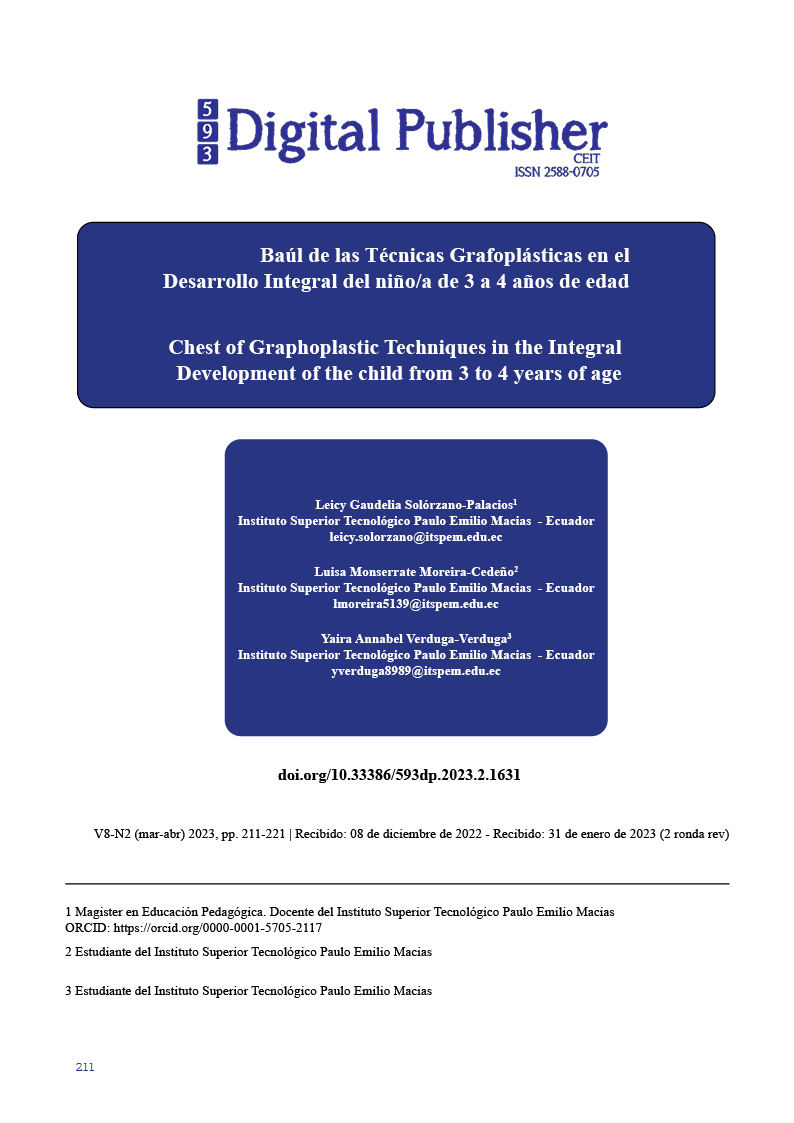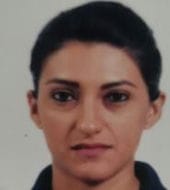Chest of Graphoplastic Techniques in the Integral Development of the child from 3 to 4 years of age
Main Article Content
Abstract
Currently, graphoplastic techniques play an important role in the teaching-learning process, being a means to develop literacy and comprehensive stimulation of the infant, such as their creative and expressive imagination. The present study focuses on analyzing the Grapho-Plastic Techniques used by teachers, for the development of creativity in children of basic education; through descriptive research, under a qualitative, non-experimental approach. The results show that by applying the graphoplastic techniques, the children improved motor and visomotor skills, all of which is positive in the integral and satisfactory development of the infant. In conclusion, when developing a trunk applying graphoplastic techniques in children from 3 to 4 years of age, whose new didactic tools described in the research will allow educators to make their work more efficient, implementing techniques of cutting, tearing, wrinkling, folded, among others; that will allow an interaction at the moment given by the child, developing certain skills, abilities and reaching domain levels.
Downloads
Article Details

This work is licensed under a Creative Commons Attribution-NonCommercial-ShareAlike 4.0 International License.
1. Derechos de autor
Las obras que se publican en 593 Digital Publisher CEIT están sujetas a los siguientes términos:
1.1. 593 Digital Publisher CEIT, conserva los derechos patrimoniales (copyright) de las obras publicadas, favorece y permite la reutilización de las mismas bajo la licencia Licencia Creative Commons 4.0 de Reconocimiento-NoComercial-CompartirIgual 4.0, por lo cual se pueden copiar, usar, difundir, transmitir y exponer públicamente, siempre que:
1.1.a. Se cite la autoría y fuente original de su publicación (revista, editorial, URL).
1.1.b. No se usen para fines comerciales u onerosos.
1.1.c. Se mencione la existencia y especificaciones de esta licencia de uso.
References
Acerete, D. (1974) Objetivos y didáctica de la Educación Plástica aportes para el apresto y guía para la escuela, Buenos Aires, Kapelusz.
Arenal, Carmen (2019). Entorno e información de mercados. La Rioja: Tutor Formación
Cando y Trujillo (2018) https://repositorio.unemi.edu.ec/xmlui/handle/123456789/4246
Cela, M. (2017). Técnicas Grafo plásticas con recursos naturales para estimular la motricidad fina en niños y niñas de 2 a 3 años en el centro infantil del Buen Vivir. Cuenca, Ecuador: [Tesis, Universidad Politécnica Salesiana Sede Cuenca].
Di Caudo, M. (2011). Expresión Grafoplástica Infantil. Quito-Ecuador: Abya-Yala.
Gallardo J. (2018). La psicomotricidad y su importancia en el desarrollo integral infantil. Dialnet, 2.
Guerrero, C. (2012-2013). Álbum de técnicas grafo plásticas. Universidad técnica de
López, A., & Martínez, S. (2017). Técnicas grafo plásticas como estrategias para el desarrollo en la motricidad fina en los niños y niñas de Infante II en el Centro de Desarrollo Infantil Monseñor Lezcano del segundo semestre del año 2017. Managua, Nicaragua: [Tesis, Universidad Nacional Autónoma de Nicaragua, Managua].
Mazón, L., & Zurita, L. (2021). Importancia de las técnicas grafoplásticas en el desarrollo de la pre-escritura en infantes de 4 a 5 años. Milagro, Ecuador: [Tesis, Universidad Estatal de Milagro].
Miranda, I. (2016). La motricidad y su influencia en el desempeño escolar de los niños/as del inicial 1A de la escuela "San José" del cantón Babahoyo, provincia Los ríos. Babahoyo, Los ríos: [Tesis, Universidad Técnica de Babahoyo].
Ponce, J. (2016). Desarrollo Infantil: situación actual y recomendaciones de política. Quito, Ecuador. BID: BID.
Quinatoa, M. M. S., & Morales, S. C. (2018). Influencia de la actividad física en la motricidad fina y gruesa del adulto mayor femenino. Revista Cubana de Investigaciones Biomédicas, 37(3), 1-13. http://scielo.sld.cu/scielo.php?pid=S0864-03002018000300005&script=sci_arttext&tlng=pt
Ramírez-Aguirre, G., Gutiérrez-Cedeño, M., León-Piguave, A., Vargas-Cruz, M., & Cetre-Vásquez, R. (2017). Coordinación grafo perceptiva: incidencia en el desarrollo de la motricidad fina en niños de 5 a 6 años de edad. Revista Ciencia Unemi, 10(22), 40-47.
Rodríguez P. (2019). Estrategias didácticas para desarrollar la motricidad gruesa en niños y niñas. Quito-Ecuador: Pontificia Universidad Católica del Ecuador.
Siavichay, M. P. U. (2021). Elaboración de un manual de estrategias metodológicas basadas en técnicas grafoplásticas para estimular la motricidad fina en niños de 5 a 6 años (Tesis de licenciatura). Universidad Politécnica Salesiana, Sede Cuenca. Ecuador.




